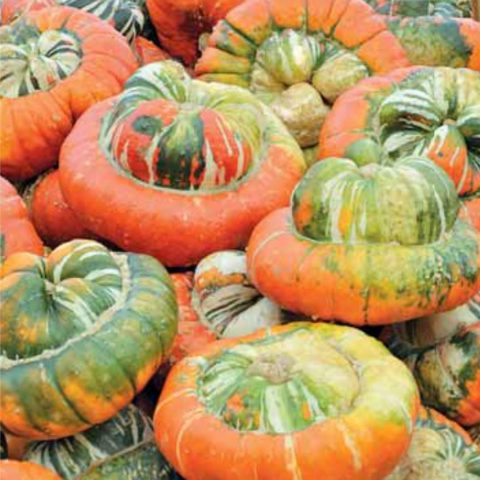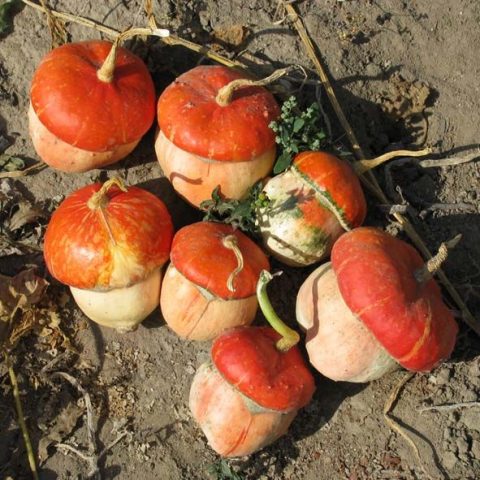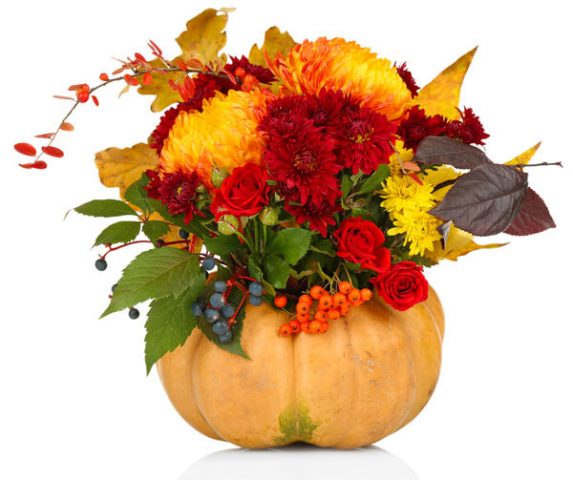Content
Pumpkin Turkish turban is a liana-like plant that grows in the wild in the tropics. Belongs to the Pumpkin family. It is generally accepted that the decoration of the garden is flowers or flowering bushes. Unusual vegetables, in particular ornamental pumpkins, do just as well.
Description of the variety
The Turkish turban is fast growing. In a few weeks, the stem can grow up to 6 m. This feature allows the pumpkin to be used for decorative landscaping. The lashes cling to the support with their antennae and quickly rise up. You can disguise a fence, mesh or decorate an arch with a climbing crop.
The foliage is large, rounded, five-lobed. The surface is wrinkled, with spiny hairs. The leaves are held on long, hollow stems. Flowers are single, large, yellow. Pumpkin inflorescences Turkish turban are predominantly unisexual. The flowering process begins in the second half of summer.
Description of fruits
The most interesting thing about the Turkish turban pumpkin is the fruit. In shape, they resemble two small pumpkins grown together. The upper part of the turbid fruit has a bright orange hue, and the lower one is painted white.
The length of the vegetable is 25-40 cm, the diameter is 15 cm. The surface can be smooth or bumpy. On the same plant, there are practically no two identical fruits. They always differ in color, pattern.
Variety characteristics
Pumpkin Turkish turban easily endures periods in the absence of rain. However, the big minus of the plant is the complete lack of frost resistance. Young bushes do not tolerate a drop in temperature even to - 1 ° C. In addition to frost, ornamental vegetables do not respond well to poor soil. To obtain a bountiful harvest, it is better to water with solutions of mineral fertilizers.
Disease and pest resistance
Pumpkin Turkish turban suffers from fungal diseases. The bushes become covered with black mold, as a result, growth and development stops.
- The most common disease in the Turkish turban variety is powdery mildew. Symptoms are white bloom on leaves and fruits. The affected areas dry out over time and fall off. You can get rid of the disease with the help of fungicides or the timely removal of the affected plant.
- Bacteriosis is characterized by brown spots on the leaves. With a prolonged process, ulcers appear. For prophylaxis, the Turkish turban pumpkin is sprayed with Bordeaux liquid. If signs of illness appear, they are treated with a mixture of copper sulfate with lime.
- Root rot affects the root system and the stem of the vegetable crop. This is due to sharp temperature changes. Diseased plants are treated with a solution of copper sulfate and zinc sulfate.
- White rot. The causative agent is a marsupial mushroom. Infection develops in conditions of excess moisture. Rotten areas are cut off and sprinkled with activated carbon. Prevention of fungal disease - moisturizing with warm water.
- Pumpkin Turkish turban suffers from melon aphids, the size of which is 2 mm. Wither, leaves, flowers fall. Get rid of the insect allows the drug Karbofos or an infusion of wormwood.
- The turkish turban of slugs gives a lot of problems to the pumpkin. During the rainy season, their activity increases. They feed on the leaves of the bush.Pests must be dealt with quickly, otherwise they can live in one place for several years. To do this, a mixture of slaked lime and ash should be distributed around the plant in proportions of 1: 1.
Is it okay to eat a turkish turban pumpkin
This question is of interest to many gardeners who plan to plant a decorative pumpkin on the site. Without a doubt, unusual fruits are often used to decorate the yard. However, the Turkish turban pumpkin can be eaten. A young vegetable has a thin, delicate skin. They prepare stews, casseroles, salads from it. Fully ripe fruits are covered with a dense, hard crust. The pulp acquires a bitter taste. Therefore, such a vegetable is used for feeding livestock.
Application of decorative pumpkin
In the garden, a pumpkin Turkish turban looks beautiful and original. The fruits stand out brightly against the green foliage of the vines, but they can be used for crafts. The vegetable is used for burning pictures, decorative painting.
To create an interior element of the composition, the pumpkin must be in a dried state. Therefore, the preliminary preparation of the vegetable consists in performing the following steps:
- sort out the entire harvested crop, selecting ripe pumpkins;
- the stalk must be completely dry;
- the fruit is washed with soapy water and wiped dry;
- transferred to a room with good ventilation for further drying;
- constantly inspect vegetables, promptly removing rotten ones;
- if mold is noticed on the peel, it is treated with antiseptic agents.
The Turkish turban pumpkin is completely dry if thrown into a container of water and does not sink. Next, you need to polish the surface of the vegetable with sandpaper. Thus, it will be possible to get rid of irregularities and peels.
After the completion of all the preparatory work, they begin to cut out drawings on the walls, paint. To increase the strength, rub the surface of the pumpkin with a Turkish turban with wax.
Pumpkin dishes are made using a drill. Holes of appropriate diameters are drilled. But first, the core is opened and the seeds and pulp are extracted.
Growing technology
The size and quantity of the harvest directly depends on the growing conditions of the Turkish turban pumpkin. It is noticed that the plant grows well in light fertile soils. Preferably loam or sandy loam, calcareous soils, and the vegetable does not tolerate acidic soil.
A secluded place, protected from cold winds, is suitable for disembarkation. Pumpkin Turkish turban is a sun-loving plant, but light shade is allowed. Without the sun, a vegetable crop grows and develops poorly. The color is dull. The more light, the more beautiful the fruit. Of course, you can plant pumpkins from the north side of the house, but then you should not expect an abundance of inflorescences and bright fruits.
Pumpkin The Turkish turban is an annual plant that does not tolerate a drop in temperature. Therefore, it is advisable to plant it in the ground in a seedling way.
- Vegetable seeds are soaked in a growth stimulant solution.
- Wrapped in cheesecloth and sent to a dark place for 2 days.
- Prepare single containers with a volume of at least 0.5 liters and a solar window sill.
- The composition of the substrate should include sod earth and sand to give a loose consistency.
- Sprouted seedlings are hardened daily. They are taken out into the street for 20 minutes first. The residence time is then gradually increased.
- The Turkish turban pumpkin is planted in open ground in late May or early June, when the night frosts pass.
- The distance between the holes is approximately 40-60 cm. The embedding depth is 15-20 cm.
- When planting a plant from a glass, you should be careful, as you can harm the roots.
- Seedlings bloom in June, and in mid-July, the first fruits begin to form.
Ornamental pumpkin needs rare but abundant watering. The soil is loosened regularly. To make the bush lush, pinch the top. And when the size of the stem reaches 150 cm, the lateral processes will go.
When the green mass is growing, nitrogen-containing fertilizers are fed. For the formation of fruits and flowers - potash and phosphorus preparations. Pumpkin Turkish turban prefers organic feeding more: chicken droppings, mullein, rotted manure, humus.
The vegetable is harvested in dry weather, around September-October before the onset of frost. In the southern regions - after the foliage has dried. In the process of harvesting, it is required to preserve the stalk and prevent damage to the pumpkin Turkish turban.
Conclusion
Pumpkin Turkish turban is an ornamental plant. Suitable for culinary or landscaping use. Handmade crafts are beautifully made from ripe fruits: vases, boxes, candle holders. Moreover, the basis for such unique things can be obtained without much effort. The vegetable culture is undemanding, grows quickly and pleases with numerous fruits.
Testimonials












